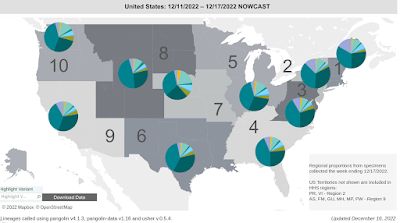XBB, which averages only 7.2% of cases nationally, is most prevalent in the Northeastern United States, where it averages 16.5% of cases. In Texas, it is estimated at only 3.2%.
All of these numbers are estimates based on limited surveillance, and previous week's numbers are often revised, meaning that they are most useful for spotting trends.
While BQ.1 and BQ.1.1 are likely to remain kings of the viral hill for the next few weeks, neither are showing the overwhelming dominance that earlier dominant strains demonstrated, making it impossible to know what the viral landscape will look like 3 months from now.
Earlier this week the UK's HSA released a revised Risk Assessment On BQ.1, BQ.1.1, and XBB (see chart below), which finds these subvariants to have a growth advantage, and increased immune escape, over the previously dominant BA.5 variant.
So far, we've not seen any evidence of increased severity of these variants over BA.5, but it may be too soon (particularly with XBB) to pick up those types of signals.
Stay tuned, we've a long winter ahead.



